warning light BUICK SKYLARK 1993 Owners Manual
[x] Cancel search | Manufacturer: BUICK, Model Year: 1993, Model line: SKYLARK, Model: BUICK SKYLARK 1993Pages: 306, PDF Size: 15.84 MB
Page 13 of 306

Vehicle Symbols
These are some of the symbols you will. find -on your vehicle.
For example,
these symbols
are used on an
original battery:
CAUTION
INJURY
PROTECT EYES BY
SHIELDING
Q
CAUSTIC
ACID COULD CAUSE
BA~~RY
BURNS AVOID
SPARKS
OR
FLAMES
SPARK
OR ,\I/,
COULD pq
FLAME
EXPLODE BATTERY
These symbols
are important
for you and
your passengers
whenever your
vehicle- is
driven:
FASTEN SEAT 4
BELTS
POWER
WINDOW
These symbols
have to do with
your lights:
SIGNALS e 9
TU-RN
HIGH BEAM
OR = =o
FOG LAMPS # 0
These symbols
are on some of
your controls:
WINDSHIELD ' ' '
. WASHER
CI 0s
-tO -1
WINDSHIELD
WASHER 8
wI*DsHIELDw DEFROSTER
WINDOW
Ltft,
REAR
DEFOGGER
VENTILATING FAN
3f
HEADLAMP -
WIPER
WASHER
EQ
L
~
These symbols
are used
on
warning and
indicator lights:
COOLANT F-
TEMP *-
ENGINE
CHARGING BATTERY
SYSTEM
RADIATOR
a
COOLANT
FUEL @
ENGINE OIL e,
PRESSURE
TEMP
OIL &
ANTILOCK (@)
BRAKE
Here are some
other symbols
you may see:
FUSE
RAD10 k
VOLUME
CONDITIONING
AIR e
HATCHBACK TRUNK
RELEASE
LIGHTER
1-i
HORN
SPEAKER
12
Page 29 of 306

When the key is turned
to “Run” or “Start,” a
tone will come on for
about eight seconds to
remind people to fasten
their safety belts, unless the driver’s
safety belt is buckled.
How To Wear Safety Belts Properly
Adults
This section is only for people of adult size.
I .El CAUTION:
Safety Belt Warning Light
:The safety belt light will also come on and stay on for
‘about’a minute.
If the driver’s belt is buckled, neither
;the tone nor the light will come on.
If your safety b ~ lig ~ ever comes on or stays
on after the front doors are closed and the
driver’s belt
is buckled, have your vehicle fixed.
If you don’t, you might not have the protection
you’d need
in a crash. There are
special things to know about safety
belts and children. And there are different rules
for babies and smaller children.
If a child will be
riding
in your Buick, see the section after this
one, called “Children.”
Follow those rules for
everyone’s protection.
=I ~
First, you’ll want to know which restraint systems your
vehicle has.
We’ll start with the driver position.
Page 110 of 306
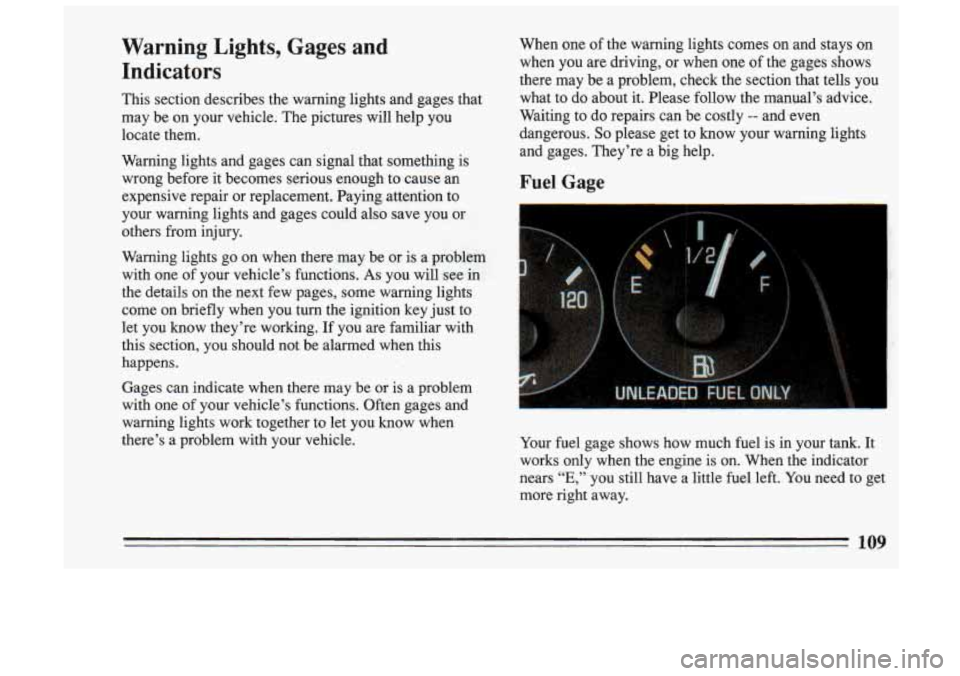
Warning Lights, Gages and
Indicators
This section describes the warning lights and gages that
may be on your vehicle. The pictures will help you
locate them.
Warning lights and gages can signal that something is wrong before it becomes serious enough to cause an
expensive repair or replacement. Paying attention to
your warning lights and gages could also save you or
others from injury.
Warning lights go on when there may be or is a problem with one of your vehicle’s functions.
As you will see in
the details
on the next few pages, some warning lights
come on briefly when you turn the ignition key just to
let you know they’re working. If you are familiar with
this section, you should not be alarmed when this
happens.
Gages can indicate when there may be or is a problem
with one of your vehicle’s functions. Often gages and
warning lights work together to let you know when
there’s a problem with your vehicle. When
one
of the warning lights comes on and stays on
when you are driving, or when one of the gages shows
there may be a problem, check the section that tells you what to do about it. Please follow the manual’s advice.
Waiting to do repairs can be costly
-- and,even
dangerous.
So please get to know your warning lights
and gages. They’re a big help.
Fuel Gage
Your fuel gage shows how much fuel is in your tank. It
works only when the engine is on. When the indicator
nears
“E,” you still have a little fuel left. You need to get
more right away.
Page 111 of 306
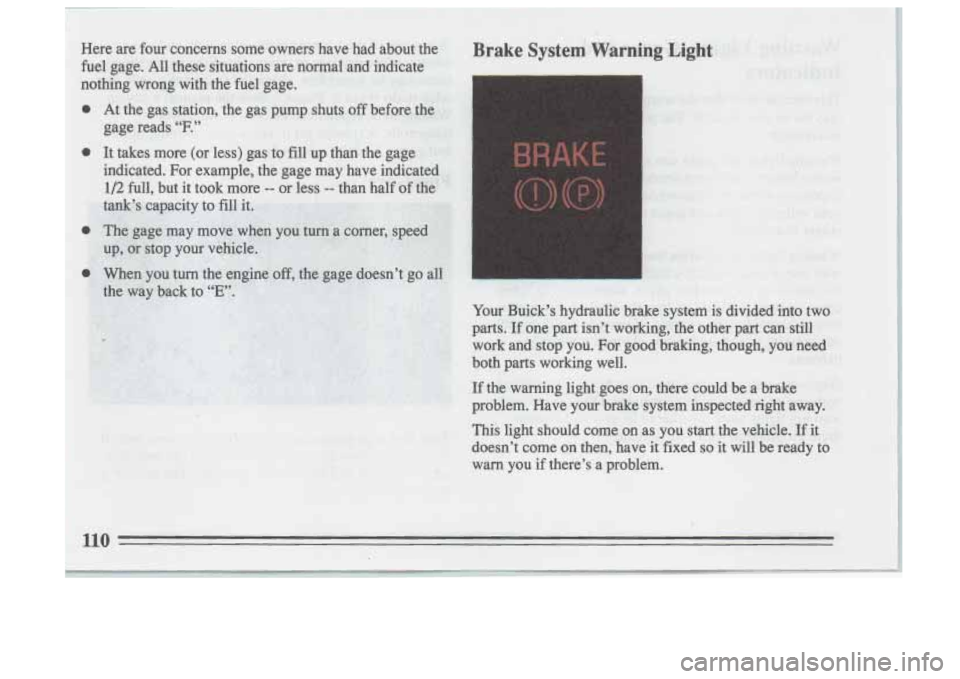
Brake System Warning Light
0 At the gas. stati0n;the gas pump shuts off before. the
gage reads “F.” 1 ,
Page 112 of 306
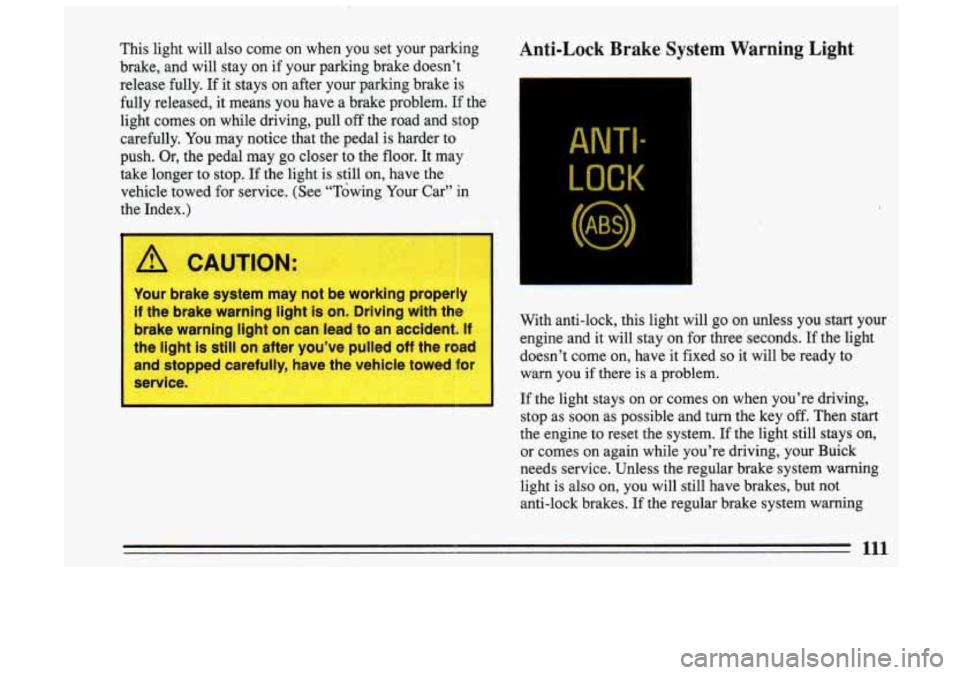
This light will also come on when you set your parking
brake, and will stay on
if your parking brake doesn’t
release fully. If it stays on after your parking brake is
fully released, it means you have a brake problem.
If the
light comes on while driving, pull
off the road and stop
carefully, You may notice that the pedal is harder to
push. Or, the pedal may go closer to the floor. It may
take longer to stop. If the light is still on, have the
vehicle towed for service. (See “Towing Your
Car” in
the Index.)
-
1
I A CAUTION:
Your brake system may not be working properly
if the brake warning light is on. Driving with the
brake warning light on can lead to an accident. If
the light is still on after you’ve pulled off the road
and stopped carefl
r, have the vehicle towed for
service.
I
Anti-Lock Brake System Warning Light
ANTI.-
LOCK
With anti-lock, this light will go on unless you start your
engine and it will stay on for three .seconds. If the light
doesn’t come on, have it fixed
so it will be ready to
warn
you if there is a problem.
If the light stays on or comes on when you’re driving,
stop as soon
as possible and turn the key off. Then start
the engine to reset the system. If the light still stays on,
or comes on again while you’re driving, your Buick
needs service. Unless the regular brake system warning
light is also on, you will still have brakes, but not
anti-lock brakes. If the regular brake system warning
111
Page 114 of 306
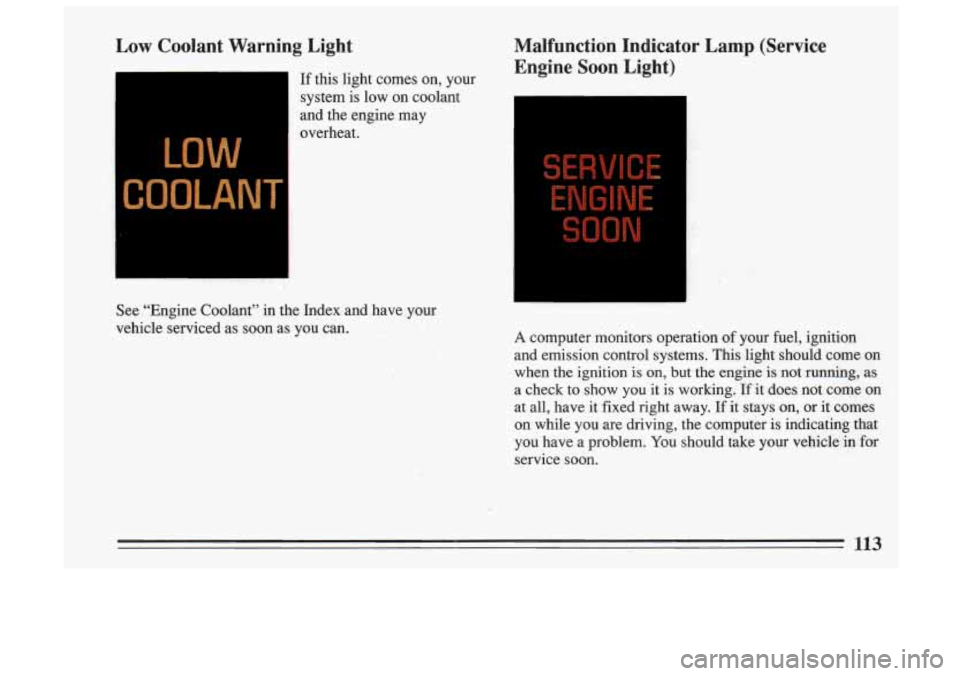
Low Coolant Warning Light
If this light comes on, your
system is low on coolant
and the engine may
overheat.
Malfunction Indicator Lamp (Service Engine Soon Light)
See “Engine Coolant’’ in the Index and have your
vehicle serviced as
soon as you can. A computer monitors operation of your fuel, ignition
and emission control systems. This light should come on when the ignition is on,
but the engine is not running, as
a check
to show you it is working. If it does not come on
at all, have it fixed right away. If
it stays on, or it comes
on while you are driving, the computkr is indicating that
you have a problem. You should take your vehicle in for
service soon.
Page 145 of 306

time. A green arrow means you may drive ir&that lane. ’
and days these systems are in effect. -,i ““ ff. 4 -’ ~‘’ - .. :
1 Look for the signs posted to warn drivers. what bQ.urs. .. . ,.
1 Pavement Markings
NO
PASSING I’
Pavement markings add to traffic signs and signals.
They give information to drivers without taking
attention from the roadway. A solid yellow line on your
side of the road or lane means “don’t cross.”
Your Own Signals
..
Drivers signal to others, too. It’s not only mare polite,
it’s safer
to let other drivers know what you are doing.
And in some places the law requires iver si.gnals.
L. ..
Turn and lane change signals. Always signal: when you
plan to turn or change lanes.
If necessary, you can use hand signals out the window:
Left arm straight out for a left turn, down for slow or
about-to-stop, and up for a right turn.
Slowing down. If time allows, tap the brake pedal once
or twice in advance of slowing or stopping. This warns
the driver behind you.
Disabled. Your four-way flashers signal that your
vehicle is disabled or
is a hazard. See “Hazard Warning
Flashers” in the Index.
Traffic Officer
The traffic police officer is also a source of important
information. The officer’s signals govern, no matter
what the traffic lights or other
signs say.
The next section discusses some of the Toad conditions
you may encounter.
._ . .-_. ;: , , .c**“jy;, “C.$ -,a,, ..,... ’ : ., - , . ,.> p :, , ,. . +.
Defensive Driving $@, *-<; .I i.?;’ * i.
, +& ’ . i *. , .. . I I- ., I.. .. \e. . *, ,
The best advice anyone can give about\driving is: Drive
defensively.
Please
start with a very important safety device in your
Buick: Buckle up. (See “Safety Belts” in the Index.)
Page 152 of 306
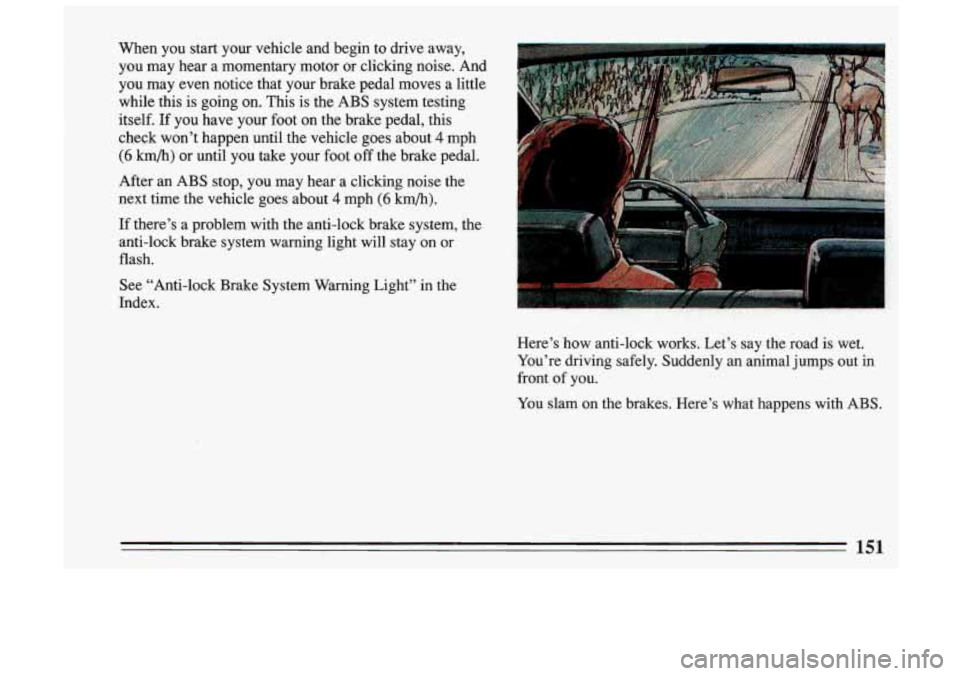
When you start your vehicle and begin to drive away,
you may hear a momentary motor or clicking noise. And you may even notice that your brake pedal moves a little
while this is going on. This
is the ABS system testing
itself.
If you have your foot on the brake pedal, this
check won’t happen until the vehicle goes about 4.mph
(6 km/h) or until you take your foot off the brake pedal.
After an ABS stop, you may hear a clicking noise the
next time the vehicle goes about
4 mph (6 km/h).
If there’s a problem with the anti-lock brake system, the
anti-lock brake system warning light will stay on or
flash.
See “Anti-lock Brake System Warning Light” in the
Index.
Here’s how anti-lock works. Let’s say the road is wet.
You’re driving safely. Suddenly an animal jumps out in
front of you.
You slam on the brakes. Here’s what happens with
ABS.
151
~
Page 160 of 306

vehicle is skidding. Learn to recognize warning clues --
such as enough water, ice or packed snow on the road to
make a “mirrored surface”
-- and slow down when you
have any doubt.
Remember: Any anti-lock braking system (ABS) helps avoid only the braking skid. Steer the way you want to
go.
Driving at Night
Night driving is more dangerous than day driving. One
reason is that some drivers are likely to be impaired
--
by alcohol or drugs, with night vision problems, or by
fatigue.
Here are some tips on night driving.
0
0 0
0
0 Drive defensively. Remember, this is the most
dangerous time. Don’t drink and drive. (See “Drunken Driving” in
the Index for more
on this problem.)
Adjust your inside rearview mirror to reduce the glare from headlights behind you.
Since you can’t see as well, you may need to slow
down and keep more space between you and other vehicles. It’s hard to tell how fast the vehicle ahead
is going just by looking at its taillights.
Slow down, especially on higher speed roads.
Your
headlights can light up only’s0 much road ahead.
In remote areas, watch for animals.
If you’re tired, pull
off the road in a safe place and
rest.
Page 169 of 306

start bralung. If you must brake on the through lane, and
if there
is traffic close behind you, you can allow a little
extra time and flash your brake lights (in addition to your turn signal) as extra warning that you are about to
slow down and exit.
The exit ramp can be curved, sometimes quite sharply.
The exit speed is usually posted. Reduce your speed
according to your speedometer, not to your sense of
motion. After driving for any distance at higher speeds,
you may tend to think you are going slower than you
actually are. For example,
40 mph (65 km/h) might
seem like only
20 mph (30 km/h). Obviously, this could
lead to serious trouble on a ramp designed for
20 mph
(30 krn/h)!
Driving a Long Distance
Although most long trips today are made on freeways,
there are still many made on regular highways.
Long-distance driving on freeways and regular
highways is the same in some ways. The trip has to be
planned and the vehicle prepared, you drive at
higher-than-city speeds, and there are longer turns
behind the wheel. You’ll enjoy your trip more if you and
your vehicle are
in good shape. Here are some tips for a
successful long trip.
Before Leaving on a Long Trip
Make sure you’re ready. Try to be well rested. If you
must start when you’re not fresh
-- such as after a day’s
work
-- don’t plan to make too many miles that first part
of the journey. Wear comfortable clothing and shoes you
can easily drive in.
Is your vehicle ready for a long trip? If you keep it
serviced and maintained, it’s ready to go. If it needs
service, have it done before starting out. Of course,
you’ll find experienced and able service experts in
Buick dealerships all across North America. They’ll be
ready and willing to help
if you need it.
Here are some things you can check before a trip:
0 Windshield Washer Fluid: Is the reservoir full? Are
all windows clean inside and outside?
WiDer Blades: Are they in good shape/
Fuel, Engine Oil, Other Fluids: Have you checked
all levels?
0 Lights: Are they all working? Are the lenses clean?
0 Tires: They are vitally important to a safe,
trouble-free trip. Is the tread good enough for long-distance driving?
Are the tires all inflated to the
recommended pressure?
168